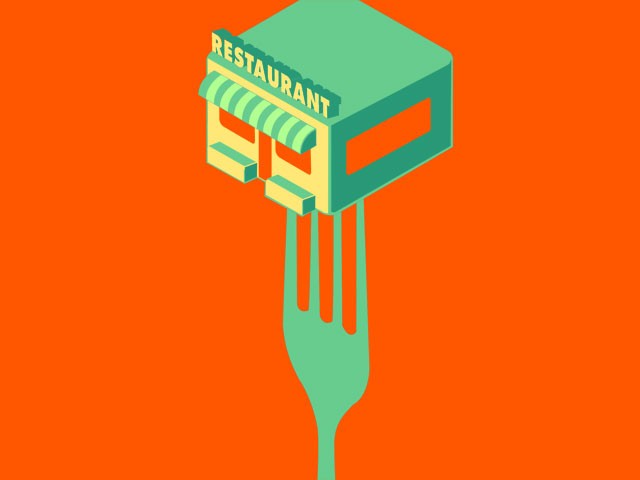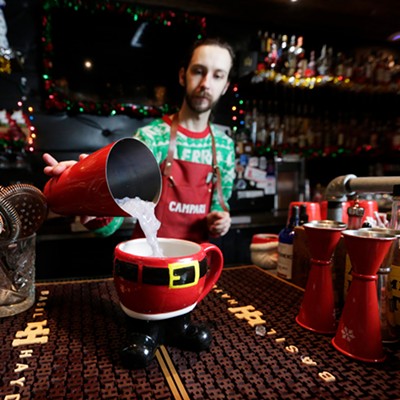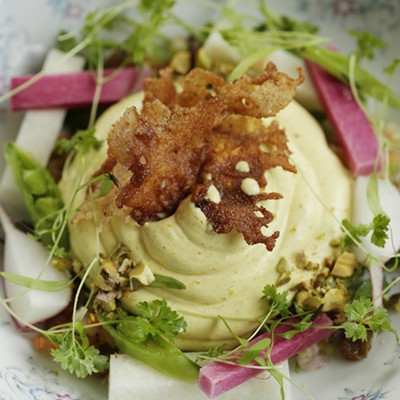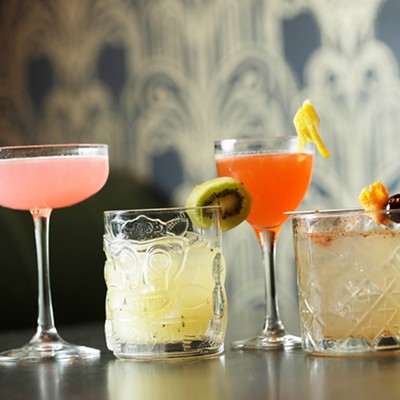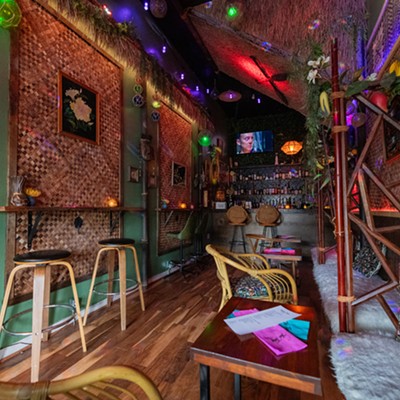The information was disseminated on a need-to-know basis. On April 2, at around 4:45 pm, a message was circulated to test the integrity of the system and to tell subjects when to expect the next communiqué. “The location will be no more than two miles from Browne’s Addition,” it said. “If driving you will be able to get within 1/2 mile of the spot ... The exact location will be e-mailed to you at 9 am tomorrow morning.”
The next morning, at 8:47 am, the second e-mail arrived: “At the corner of Sunset and Government Way, behind the church, is the freshly constructed trailhead.” The directions were terse and included a map. “From the trailhead proceed via human power along the trail for just over 1/2 mile.” The operation was called Pop-Up #1. The destination was a spot along the newly paved Fish Lake Trail.
The message detailed several logistical hurdles. The sender urged temperance and Gore-Tex — “Patience will be the theme of the day” — and concluded with a timeframe for the operation.
“Things start at noon and should last for two hours,” the message read, “perhaps more if the burgers are cooking slow.”
By the time many recipients got the e-mail, its sender, David Blaine— chef at Latah Bistro, but today, food commando — had loaded his ordnance (a picnic tent, a small grill and just over $100 in baby arugula, hand-baked buns, locally grown heritage beef, peppers, onions, pickles and an under-appreciated condiment called romesco) onto a bicycle and ridden off into the woods, preparing to “commit random acts of food.”
There’s suddenly an insurrectionist distemper in local food, and Blaine isn’t the only insurgent. The problem isn’t just that restaurants “play to the middle,” in Blaine’s words. It’s that restaurants are the only option. In different ways, and for different reasons, some of the area’s top chefs are fomenting food revolution. They want change. Innovation. They want hole-in-the-wall deli counters selling nothing but artisanal meats. They want food carts selling escargots in paper cups. People have gotten really comfortable talking about how great a place Spokane will be in five years.
These guys are thinking, Why not this summer?
A little more than six weeks later, flanked by the century-old warehouses and barbed-wire-topped fences of Pacific Avenue in downtown Spokane, valets hustled finely dressed men and women out of their Audis and Escalades into an unmarked building whose walls were painted stark white, save for the large flat-screen TVs recessed into them.
It was roughly 6 pm on a Sunday and still light, but the street had taken on the gauzy yellow incandescence of an early spring evening. Guests were greeted with elegant flutes of Cristal and left to mingle. As more people showed up, the anteroom filled shoulder-to-shoulder.
Meanwhile, behind a white partition and past two mammoth tables with place settings for 30 each, Jeremy Hansen and a team of about a dozen worked feverishly to prepare the first course in what, when all was said and done, would be a marathon 15-course tour de food. The evening was a collaboration between Hansen’s restaurant Santé and the branding firm the Purple Turtle.
The event’s name was simple — 15 — but the menu was incredibly complex. The 11th course consisted of chocolate-braised Berkshire belly, fleur de sel and sauce Champoux. The seventh was Millefeulle of foie gras and black cherry chaud-froid with a “petit verdot sphere of effervescence.” A culinary naif like myself would have benefited from a copy of The Chef’s Companion and a minor in French. The evening lasted well into the early morning — nearly eight hours in all. It’s perhaps not prudent to assign a general mood to more than 60 people, especially when they’ve each spent $300 to attend an event, but the tenor throughout seemed a mix of puzzlement and exhilaration.
People became plainly exhausted as the meal stretched to consume an entire third of a day, but they could still be seen during the final course working collaboratively to suss out which was the port gelée and which were the creme anglaise pearls.
In talking with Chef Hansen after the fact, puzzled exhilaration was exactly the point.
The surface differences between Blaine’s Pop-Up and Hansen’s 15 are obvious. Subtler and perhaps more numerous, though, are the similarities. Blaine and Hansen both, in their own way, want to shake up Spokane’s food scene while also making people aware of what they feel are incredible products and opportunities not far past our doorsteps.
Both are admirers of the offerings of area farmers. They source their events the way they source their restaurants, as locally as possible. Both express optimism about the quality of food in the area — and how it’s getting better all the time — but both struggle to come up with restaurants they consider innovative.
It’s clear from their output — Blaine’s been on the leading edge of local sourcing for years; Hansen’s a local pioneer in charcuterie — that innovation is important in their restaurants. But it’s clear too that the collective face-slap-bucket-of-cold-water treatment they want to deliver to area food consumers needs a venue that doesn’t have regular business hours.
For Blaine, it’s a populist sentiment, a desire to get food costs as low as humanly possible, making it easier to get good, healthy, well-thoughtout meals delivered to as many people as he can.
“The model we have is so damn inefficient,” Blaine says, of the dominant American restaurant experience. “You walk in, a teenager says, ‘Two?’ and takes you back to your seat, then someone else comes and takes your order. It’s like Catholic Mass — all sitting and standing and genuflecting — and you think about how much of that $8 you’re paying for the salad is actually food cost.”
He wasn’t allowed to charge for the meals during Pop-Up #1 — more on that later — but his suggested donation was $5, less than a Value Meal at just about any fast-food restaurant in America. For that price, diners got handmade buns, locally grown beef and a fresh, light arugula salad.
It wasn’t an overabundance of food, but everyone we spoke with left full. Blaine was able to do it all (donating his time and using volunteers) for $153.
Like Blaine, Hansen wants 15 to be about getting people to be mindful of food choices, but for him, it’s so that people appreciate food as art.
He says it’s always about the art at Santé, and he’s disdainful of chefs who cater too much to a perceived clientele, but in order to get truly creative he needed a one-night-only event.
“[Sante] is just such intense work,” he says, “I needed to take the concept out of here to get it jump started.” Much hay was made about the event marking the debut of molecular gastronomy in Spokane, and the pearls and glass domes and pasta made from cantaloupe were big deals, but people marveled just as much over unique flavor combinations and excellent execution. It was fun to mix and match chocolate caviar, sauce Champoux and a cube made of bacon powder in Course 11, but the clear centerpiece of the plate was an exquisitely braised pork belly.
“If people don’t respect it,” Hansen says, speaking about food, “they don’t care about it.” And you don’t get people to respect your food — especially when you want them to think of it as art — by excessive hand-wringing over their reaction. “You have to put your heart and mind into it,” he says. “If you just give people what you think they want, it’ll work for a while and then it won’t.”
He wants 15 to be the once- or twice- or three-times-ayear spectacle that changes people’s day-to-day opinions of food. He’s seen it work before. “It sparks passion in people’s eyes,” Hansen says, “to demand more out of our restaurants and chefs and, more than anything, our restaurant owners.”
Perhaps most important among the similarities in Hansen and Blaine’s missions is that they’ve been equally successful.
Both Pop-Up and 15 sold out completely.
From the sidewalk at Seventh and Front Street in Coeur d’Alene, there was nothing to suggest that a restaurant had appeared in the lobby of the McEuen Terrace condominiums. Indeed, there wasn’t much signage to suggest you were, in fact, looking at the McEuen Terrace.
Creeping closer, up stairs sandwiched between an elevated patio and a meandering waterfall, hints emerged that this was the place. A handful of people stood out on the deck mingling. Some seemed to know each other quite well. Others clearly didn’t.
Through an unmarked door guarded by a suspicious server, a table with seating for 16 had been set diagonally in one of the condo building’s common rooms. In an alcove at the back, separated from the fray only by the fact that his back was turned most of the night, Adam Hegsted — who made his name at Brix and Le Piastre and is lately the executive chef at the Coeur d’Alene Casino — was preparing the first of several courses that would comprise Wandering Table, a traveling supper club he started in March.
At the casino, Hegsted oversees food operations that feed close to 36,000 people a month. Here he was cooking for 16. Wandering Table, then, is an opportunity to refine his technique, get back in touch with all aspects of food preparation and play with some of his stranger ideas.
For Jana Tritto and the other diners, it was a little like seeing U2 play a small Dublin pub with a capacity of 50.
“I met him and just had to be a part of this,” Tritto said.
Hegsted acted as a server for many of the courses and when people asked, he gave thoughts on preparation and technique. He mentioned that the parmesan soup was actually made with a parmesan stock. Diners were incredulous, wanting to know how such a thing was possible. They talked over each other. “I’ll explain it,” he said, cutting in. “It’s basically just the outside rind of the parmesan, boiled down and just simmered forever. It’s pretty much all parmesan.”
“Who thinks of this stuff?” one woman asked rhetorically.
“I’m going to look at my leftovers differently,” Tritto responded.
Among the group was a woman who had worked at Caterina Winery; an engineer at Avista; Brian Estes, who runs the Community Garden in Vinegar Flats and his girlfriend, Mary-Kate Wheeler, visiting from Vermont.
It was an eclectic group all gathered in appreciation of Hegsted’s creativity. Wheeler hadn’t come all the way from Vermont just for the dinner, but her colleagues at a sustainable development school there were waiting for a full report.
One particularly cheeky, inventive course played on baked beans, adding smoked-salmon bacon, charred onion and copious pine nuts that, when cooked, took on the texture of al dente navy beans.
The table delighted in it, but Tritto’s husband, Jim Brand — a man with the looks and hard-worn joie de vivre of Sam Elliot — had a request. “Chef, do you got any ketchup?” He would be our entertainment for the evening.
Between courses, the talk meandered, touching on serious and absurd things. Topics included theater arts, computer programming, equine end-of-life issues, Turduckens, the Counting Crows, the difference between hydronics and hydrology, strange baby shower games, food phobias and the steady progress of photovoltaics.
Just before the dessert courses began, Hegsted walked out with chocolate truffles skewered on flimsy reed-like sticks stuck into a bed of grass. It looked like a Dr. Seuss dreamscape. He set it in the middle of the table and walked away, leaving it to sit for three courses. The intent, he told me later, was to create a moment of theatrical confusion: “I wanted to get people talking.”
By the end, a unique kind of community had sprung up here in less than three hours. People who in the normal course of things might not have much reason to talk, when put at close quarters and supplied with thoughtful food and eclectic company, opened up to one another.
As the final dessert course was served, the table offered Hegsted, his brother Ryan Stoy and their crew a round of applause.
Then Jim Brand asked one final time for some ketchup.
The excitement for these events is palpable among foodies. People haven’t just heard of Pop-Up and 15 and Wandering Table, they’ve started to take sides. It’s not hard to find someone expressing indignation that anyone would charge $300 for anything, let alone a meal. Mitch Silver, though, the local auctioneer and owner of the Bing Crosby Theater, liked the idea of 15 so much he bought six tickets — the entire chef’s table, at $500 apiece. Spokane City Councilman Jon Snyder, who turned up at Pop-Up #1, is very supportive. “It’s the kind of creative, spontaneous entrepreneurial impulse we used to think we’d have to go to another town to enjoy,” he says.
Single-engagement meals aren’t new. They’ve been happening in culinary capitals like Portland, Chicago and New York for years, often as a way for young chefs to make a name for themselves and, in Blaine’s words, as “a way to break into the money stream.”
What’s remarkable about the Inland Northwest variety is the way they have arisen all at once, and how quickly they have caught on. Hegsted’s first event was in March. Blaine’s was in early April and Hansen’s was in mid-May.
Hegsted has held a total of three events to date, as has Blaine. Every one has sold out, either by taking the maximum number of reservations or just by selling all the food they brought with them. Hegsted’s normal reservation cap is 12, but he’s seated 14 to 16 people each time. At a Wandering Table event at Quillisascut Farms in Rice, Wash., a town 80 miles northwest of Spokane, he set the limit at 20. “We had 29 people come.”
He has Wandering Table events planned monthly, and he’s sold out through August.
Hansen is planning his follow-up for October and then an absinthe masquerade for New Year’s. He gets so excited about the possibilities he punctuates his thoughts with explosion sounds, “It’d be an all-nighter — boosh — just a huge spread — boosh — with pewter goblets — boosh — and wooden spoons … maybe no silver at all — just meat knives!”
With no lack of enthusiasm or ideas from any of the chefs and no shortage of support from the community, the biggest problem for these events is the law.
See, as the law stands now, Pop-Up isn’t a legal event, and Wandering Table may not be either. Hegsted is banking that a loophole surrounding private events will get him around the permitting process.
Blaine tried that loophole himself. It didn’t work. He tried taking donations. That didn’t work either. He’s been talking with the Spokane Health District since 12 hours after his first Pop-Up e-mail, in March.
He’d love to get a permit for it, he says, “but there is literally no place for me.”
Ray Byrne of the Spokane Regional Health District puts it succinctly. Any food purveyor that doesn’t have a fixed location and isn’t operating out of a certified mobile food unit (like a taco truck) has to get a Temporary Food Establishment (TFE) permit.That’s all there is to it.
And in order to get a TFE, you need to be tied to an existing event. Like Bloomsday. Something the Health District recognizes.
Carte Blanche
There are established food permits for brick-and-mortar restaurants, food trucks and one-time events. But things like supper clubs and David’s Blaine’s Pop-Up restaurant don’t fall into any of these categories, leaving them in a legal gray area.
Legal:Traditional Restaurants
This one’s pretty straightforward. You tell the Health District your location, any construction plans, what type of food you’re going to serve and what kind of equipment and cleaning and storage facilities you’ll have. (This is true of all establishments on this list.) They tell you if that works for them. You make changes to your plan until it meets their standards. Inspections follow to make sure you’re following the law. Complex Restaurant permits cost $750 per year. Other start-up costs — construction, non-food permits, equipment — run in the hundreds of thousands.
Legal: Caterers
Caterers need to have access to an approved catering kitchen or a supplemental kitchen (fees are $440 and $230, respectively). Their menus must be approved by the Health District, and if they change, must be reapproved. Caterers must operate in conjunction with a qualifying event or in conjunction with a contractual agreement to supply a given number of meals to a specific entity. “Caterers can’t just set up outside the health department here,” say Ray Byrne of the Spokane Regional Health District.
Legally Gray:Supper Clubs
Any food service open to the public — even if the food is free or you accept donations — needs a permit. A supper club-type event could work if you have a catering license and get some benevolent contractor to create the event for you. The catering option becomes less cost-effective, though, for chefs who don’t already have access to commercial kitchen (they’d need to build or rent one). Local chefs would like these types of dinners to be considered a Temporary Food Establishment, but they aren’t right now. (Also see Pop Ups.)
Legal:Food Trucks
Food trucks (like Tacos Tumbras, El Sol de Mexico, the guy who sells the German sausages by the courthouse) need to exist in a certified vehicle, which can cost tens of thousands of dollars. The permit itself runs you about $520. This is a good low-cost solution if you want to be out and about every day, slinging the same kind of food. But if you only want to do this once or twice a month, the costs probably won’t pencil out.
Legal:Temporary Food Establishments
Vendors who want to pitch a tent on the side of Race for the Cure or Pig Out in the Park can obtain a Temporary Food Establishment (TFE) permit. Byrne says these events must be “Fixed location, fixed menu, [and not to exceed] 21 days in conjunction with a fair or festival.” The permit is $480 for the duration of the event, and $270 for a second booth. If you want this to be a recurring deal, that’s an additional $350.
Legally Gray:Pop-Ups
David Blaine’s Pop-Up restaurant idea would work fine as a TFE, except the health code states that you can’t have a TFE permit unless your food event is attached to some other kind of permitted event (like Pig Out in the Park). Requesting a variance from the code requires a fee of $125 — almost more than Blaine spent on food and sporks for his first Pop-Up outing. And there’s no guarantee the Health District will grant the request. — Luke Baumgarten and Heidi Groover
But Blaine doesn’t want to be hamstrung to an event. “The food should be an event in itself,” he says.
Byrne says if that’s the case, “we would try to push them into a category more like a mobile unit.” But food trucks can run tens of thousands of dollars. (For a complete picture of the laws, see “Carte Blanche” page 22) The code is written that way on purpose, Byrne says, to restrict entry to a degree — “they’re trying to prevent anybody from going out any time and setting up on any street corner.”
It’s a slippery-slope mentality that Byrne says partially has to do with “environmental factors” and utilities access but mostly comes down to manpower. It would be a nightmare tracking down hundreds of guys with grills and tents.
There’s a positive note for people with catering licenses. Hansen was able to use Santé’s catering permit for 15, but one aspect of the code is that every time you appreciably change your menu, it needs to be reapproved. Hansen says because of the complexity of his menu, the process is grueling. “I had to go in front of the Health Department board, and they drilled me for two hours about every aspect of it.”
Neither Blaine, Hegsted nor Hansen begrudge inspectors due diligence in matters of food safety. “I know all those guys, and like them,” Hegsted says of North Idaho inspectors. Hansen felt the board was helpful and worked with him, saying, “They see [this movement] happening and they’re trying to understand it.” He does wish there was some way to streamline the process.
Blaine wants to add a moral imperative component to the way we think about our food regulations. Rather than just thinking in terms of budget and manpower, Blaine wants us to ask, “What do we gain as a society by moving in this direction?” For a class of food vendors that operate like Pop-Up, “if it’s a way to lower the price of high-quality food, then that’s a worthwhile endeavor.”
Byrne says it’s unlikely their codes will change until the state code changes.
Councilman Snyder says the city has no control over the Health District and thus all direct action needs to be taken through them. There’s an undeniable economic impact to this, though, he feels. “I like it when people spin the development angle, because it is one.”
In towns like Seattle, where the Office of Economic Growth put its stamp of approval on street vendors of all sorts — not just food places — as economic incubators, that stamp helped spur regulatory bodies and neighborhood councils to take a look at where such things might fit.
“The situation in Seattle is interesting,” Snyder says. “That’s a nice thing about living in the same state as a city like Seattle: We’re all working under the same rules. When they change something, we can look at changing it, too.”
As a last note, Byrne said the state food code is undergoing revision and that “they’re open for comment right now.” He encourages people like Blaine and foodies in general to plead their case.
The new code isn’t set to be adopted until September 2011, though.
There’s no indication the food uprising is going to wait until then. In fact, it’s about to get a new member.
The sexiest voicemail message you’re ever likely to hear outside the sex industry goes like this [italics denote extra sexiness]:
“If you’re listening to this message, you must be one of the select few invited to the … Ghetto Gourmand launch event. To secure your spot, leave the following: your name, your cell phone number and your e-mail address. This information will guarantee you an entrance password and updates on the secret location. Thank you very much, have a fantastic time.”
When Amy Nathan moved back to Spokane from Miami, she set out with her friend Teri Dykeman to craft experiences unlike anything you could find around here. They landed on the idea of clandestine supper clubs after seeing them operate in places like Miami, Chicago, New York, L.A.
Even before the launch party and before any significant press, their first public event, June 21’s “Midsummer Night’s Dream,” is already almost sold out.
Daniel Gonzalez — a 26-year-old who spent the last eight years in Seattle, first in culinary school and then at a variety of restaurants including Restaurant Zoe, Le Pichet and Lark — has signed up for the launch party and the first two events. Gonzalez moved back to Spokane recently to be near family and with hopes of one day opening his own restaurant in Coeur d’Alene. He has high hopes for the exposure it’ll offer. “I really hope it’s going to be a good networking thing,” he says.
The menu he’s preparing is a “speakeasy theme, so everything’s going to have cognac incorporated somehow some way,” he says. “There’ll be pork belly, foie gras terrine.”
Gonzalez, 26, displays some of the same intensity as Hansen, Hegsted and Blaine: a man with a taste for revolution. “I’m a young guy,” he says, “and I’m hungry to get it done.”
Nathan says she’s working with the Health District to get the proper permits through the entertainment company she runs with Dykeman.
It’s clear, though, that the air of exclusivity and secrecy is an indelible part of the allure. These events will keep their underground feeling even if they’re aboveboard.
I mean, who doesn’t like passwords?
By nature, these events don’t lend themselves to the public display of dates/times/locations. If you’re interested in attending, it’s going to take a bit of detective work. Here are your leads: Pop-Up, popupspokane.tumblr.com; Wandering Table, thewanderingtable.com; Ghetto Gourmand, ghetto-gourmand.com; 15, experience15.com.

